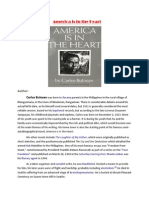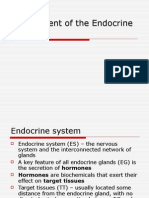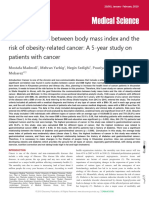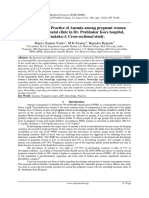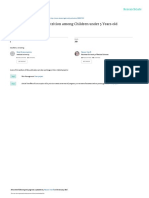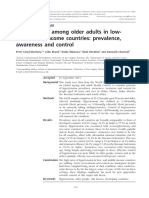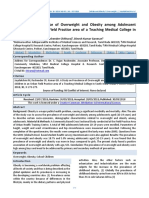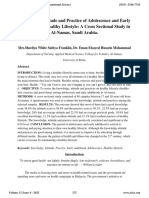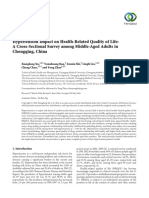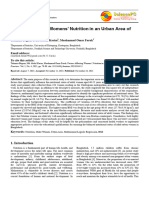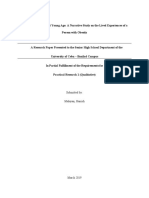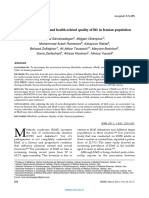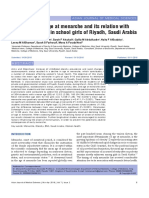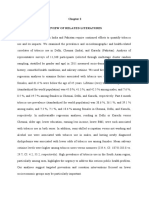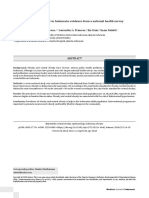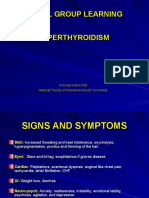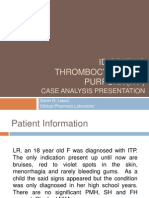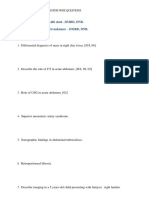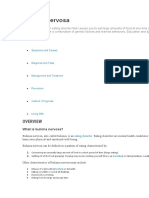Overweight and Obesity and Associated Risk Factors Among The Iranian Middle-Aged Women
Overweight and Obesity and Associated Risk Factors Among The Iranian Middle-Aged Women
Uploaded by
agnesCopyright:
Available Formats
Overweight and Obesity and Associated Risk Factors Among The Iranian Middle-Aged Women
Overweight and Obesity and Associated Risk Factors Among The Iranian Middle-Aged Women
Uploaded by
agnesOriginal Description:
Original Title
Copyright
Available Formats
Share this document
Did you find this document useful?
Is this content inappropriate?
Copyright:
Available Formats
Overweight and Obesity and Associated Risk Factors Among The Iranian Middle-Aged Women
Overweight and Obesity and Associated Risk Factors Among The Iranian Middle-Aged Women
Uploaded by
agnesCopyright:
Available Formats
120 International Journal of Collaborative Research on Internal Medicine & Public Health
Overweight and Obesity and Associated Risk Factors
among the Iranian Middle-Aged Women
Raheb Ghorbani 1, Mohammad Nassaji 2*, Jafar Jandaghi 3, Bemane Rostami 4,
Narges Ghorbani 5
1
Associate professor of Biostatistics, Research Center for Social Determinants of Health, Department
of Community Medicine, Faculty of Medicine, Semnan University of Medical Sciences, Semnan, Iran
2
Associate professor of Infectious diseases, Research Center for Social Determinants of Health,
Faculty of Medicine, Semnan University of Medical Sciences, Semnan, Iran
3
Research Center for Social Determinants of Health, Faculty of Medicine, Semnan University of
Medical Sciences, Semnan, Iran
4
General physician, Semnan University of Medical Sciences, Semnan, Iran
5
Medical student, Semnan University of Medical Sciences, Semnan, Iran
* Corresponding Author: Mohammad Nassaji (MD)
Kovsar Hospital, Basij Blvd, Semnan, Iran
Tel: +98 2333437844 Fax: +98 2333437837 | Mobile: +98 9121318640
Emails: hnassaji@yahoo.com, mnzmohammad@gmail.com
Abstract
Background: Overweight and obesity is considered to be a worldwide epidemic that its
incidence is increasing and has become a global public health. Overweight and obesity
has significant contributing factor in the development of various chronic diseases such as
cardiovascular disease, hypertension, diabetes mellitus, stroke, osteoarthritis, and certain
cancers.
Objectives: To assess the prevalence of overweight and obesity in a group of Iranian
middle-aged women and the association with some socio-demographic factors.
Methods: The study was undertaken among women aged 40–60 years in Semnan, Iran.
The Body Mass Index (BMI) was calculated by measuring height and weight. Socio-
demographic variables collected were age, marital status, household income,
employment, educational level, residential area, number of children, life satisfaction and
menopausal status.
Results: A total of 749 women were included. The prevalence of overweight/obesity was
high (80.8%). Educational level and menopausal status were strongly associated with
obesity. Other socio-demographic variables were not significantly associated with
overweight/obesity. Comparison with two previous studies in this region showed that the
prevalence of overweight is increasing in women.
Vol. 7 No. 6 (2015)
121 International Journal of Collaborative Research on Internal Medicine & Public Health
Conclusions: This study showed high prevalence of overweight and obesity in middle-
aged women. Overweight and obesity have had no significant association with most
socio-demographic variables.
Key words: Overweight, Obesity, Middle-aged women, Socio-demographic
characteristics
Introduction
Obesity is considered to be a worldwide epidemic that its incidence is increasing. It has
become a global public health and more than one billion adults estimated to be
overweight and over 400 million of them are obese.1 According to the WHO estimate,
there will be about 2.3 billion overweight people aged 15 years and above, and over 700
million obese people worldwide in 2015.2
Obesity has significant contributing factor in the development of various chronic diseases
such as cardiovascular disease, hypertension, diabetes mellitus, stroke, osteoarthritis, and
certain cancers.3 According to the previous data, there are wide variations in the
prevalence of obesity throughout the world, ranging from India, where 1% or less of the
population is obese, to the Pacific Islands, where the prevalence of obesity can reach up
to 80% in some regions.4
Although obesity was initially most visible in developed countries, recent global figures
indicate that it is increasing in the developing world. As developing countries have
become wealthier, marked change in lifestyles cause obesity development.5 So that WHO
emphasizes the importance of monitoring the prevalence and secular trends for
overweight and obesity in each country.6
The prevalence of obesity among men and women varies greatly within and between
countries. Women, in particular, have a higher prevalence of obesity that increases with
age.7 These gender disparities are exacerbated among women in developing countries,
particularly in the Middle East and North Africa.8 Some studies suggest that not only the
global differences in the prevalence of obesity vary by sex, but also that the social
determinants of obesity vary by gender.9,10
Iran is a middle-income developing country undergoing economic, environmental, and
cultural changes. Lifestyle and diet have significantly changed in recent years. These
changes negatively affected both energy intake and expenditure.11
In middle-aged women, the biological factor and hormonal changes affects fat
distribution that may increase risk or exacerbate negative effects of obesity on health.
These biological and related socio-cultural differences warrant specific study on women.
Understanding how regional body mass indexes are changing in women, and the relative
Vol. 7 No. 6 (2015)
122 International Journal of Collaborative Research on Internal Medicine & Public Health
speed at which this is occurring, is important for health planning policy and
intervention.12
Few studies have explored this topic in middle-aged women. Identifying the important
determinants of overweight/obesity may help to define target groups for prevention. So
that this study designed to evaluate obesity in a group of middle-aged Iranian women and
comparing the result with two previous study that conducted in this region. We also
examined the associations of overweight and obesity with demographic and
socioeconomic characteristics. This article is the first nationwide obesity prevalence
study among women aged 40-60 in Iran.
Methods
This cross-sectional study was conducted during 2012 in Semnan city that is situated in
center of Iran. This city consists of seven districts. Each district is covered by a Primary
Health Care center (PHC). The target population in this study was women of middle age
(40-60years) in all seven regions.
A multistage stratified cluster random sampling technique was used to select study
population. In the first stage, clusters (households) were chosen randomly using
systematic sampling technique based on family health number in PHC centers. In the
second stage, we randomly selected subjects in each cluster. Once a household was
selected, all residents were identified by age and sex, and one women aged between 40-
60 years was randomly selected. If there was not a woman with above age, the next
household selected, until calculated sample attained. The study was approved by the
Research and Ethics Committee of the Semnan University of Medical Sciences and
informed consent was obtained from all subjects.
Data was collected face-to-face by trained interviewers using a structured questionnaire
comprising data on social, demographic and personal history. Weight was determined
using a digital electronic weighing scale with accuracy to 0.1 kg and wearing lightweight
clothing. Height was measured to the nearest centimeter by using a tape measure and
women standing upright without shoes. Body mass index (BMI), defined as the weight in
kilograms divided by the height in meters squared (kg/m2). Overweight defined as having
a BMI between 25.0 and 29.9 kg/m2; and obesity as having a BMI equal or greater than
30.0 kg/m2.6
The small number of underweight participants in this study made accurate inference
about this group impossible. Therefore, this category was removed from analysis. Data
about socio-demographic details including age, marital status, household income,
employment, education, residential area, number of children, life satisfaction and
menopausal status were registered. The menopausal status was defined based on WHO
criteria.13 Household income and life satisfaction was based on self-reported information.
Vol. 7 No. 6 (2015)
123 International Journal of Collaborative Research on Internal Medicine & Public Health
Statistical analysis
Data were analyzed by Chi Square test (for univariate analysis) and logistic regression
analysis using SPSS Version 16.00(SPSS, Inc., Chicago, IL). P-value less than 0.05 were
considered statistically significant. We used logistic regression analysis to estimate
adjusted odds ratio (OR) of obesity for different levels of risk factors.
Results
The study enrolled 749 middle age women. Mean age (±SD) of participant was 50.7 ±4.5.
Most participants were married (94%), minority of women (8%) have had high level of
education (>12 years) and 661(83.3%) were non-employed. The main characteristics of
subjects are presented in Table 1.
Mean BMI (±SD) of women was 28.6±4.3 using the WHO criteria. 19.2 % of women
were normal weight, 45.4% overweight and 35.4% obese. The combined prevalence of
both overweight and obesity was 80.8%. Table 2 displays relationships between socio-
demographic variables and the likelihood to be classified as overweight or obese.
Overweight and obesity were not significantly associated with age, marital status,
education level, number of children, place of residency, employment, life satisfaction,
household income and menopausal status.
The associations between the risk of obesity and the socio-demographic factors in
multivariate models showed that education level and menopausal status was associated
with increased chance of obesity. The risk of obesity was more common by
approximately 1.52 fold in women with<12 year of education (OR=1.52, 95% CI: 1.09-
2.10, p=0.01). In addition, the risk of obesity was 1.58 time more common in pre-
menopause women when compared with menopausal women (OR=1.58, 95% CI: 1.06-
2.36, p=0.026) (Table 3).
Discussion
Obesity is caused by a complex interaction between the environment, genetic
predisposition, and human behavior. Environmental factors are likely to be major
contributors to the obesity epidemic.4 Recent estimates show the prevalence of
overweight and obesity to be increasing at alarming rates, in both developed and
developing countries.14
This study found that the prevalence of overweight and obesity among middle-aged
women was high. In a systematic-review and meta-analysis, obesity was reported in
13.7% of Iranian adult males and 27.3% of females.15 This shows that prevalence of
obesity in this group is significantly higher than general adult female.
Vol. 7 No. 6 (2015)
124 International Journal of Collaborative Research on Internal Medicine & Public Health
The prevalence of overweight/ obesity in this study (80.8%) was higher than the value
reported in women of China, Swiss, Portuguese, Italia, Malaysia, Ghana, Tunisia.16-22 A
similar prevalence of obesity among women in Turkey (35%) was reported.23 Most of
these studies were conducted on all adult women not in middle-aged group. In a study in
Shiraz, southern Iran that conducted on 25-55 adult the prevalence of overweight/obesity
was 63.9% in women. The prevalence of obesity was 22.5% in women.24
Compared with our study, Dijkshoon reported higher prevalence of obesity among
Turkish and Moroccan immigrant women (89%) in The Netherlands.25 Mbochi and co-
worker from Kenya reported a higher BMI in women aged 40-60 compared with our
finding.26
Our finding for overweight and obesity was compared with two previous studies
conducted in Semnan during 1996-97 and 2006.27.28 In the 1996-97 study 75.3% of
middle-aged women have had overweight/obesity. The study revealed overweight in 37%
and obesity in 38.5% of women. In 2006 study prevalence of overweight/obesity was
78.2%. Prevalence of overweight and obesity was 43.5% and 34.7% respectively. Figure
1 shows an increase in overweight during a sixteen -year period between the three
studies. On the other hand, findings show a slight decrease in trend of obesity during this
period.
In Tehran Lipid and Glucose Study conducted on adult above twenty years old between
1998 and 2002 the prevalence of overweight slightly decreased from 40 to 39.5% in
women. Whereas, obesity have risen from 43/8% to 49.9% in women.29 Such increase in
the prevalence of overweight/obesity may be due to change in lifestyle and nutrition shift
in Iran. The increasing economic status in recent years has resulted in a higher
consumption of sugar, salt, red meat and saturated fatty acids among Iranian people and
therefore increased the possibility of becoming obese.30
Most other studies from developing and developed countries have documented similar
increase. Balarajan et al examined trends in the prevalence of overweight/obesity and
underweight among women of reproductive age in 3 South Asian countries. The
prevalence of overweight/obesity increased substantially in all countries.31 In study on
adult Swiss population between 1992-3 and 2007, the prevalence of overweight/ obesity
increased from 22.3% to 31.3% in women, while the prevalence of obesity increased
from 4.9% to 8.5% in women.17 Similar increase was reported from some other studies.32-
34
In contrast Al-Lawati and Jousilahti in their study reported decrease in overweight and
obesity between 1991 and 2000 among Omani adult women.35 A similar decrease was
reported among adult women from Spain. This decline was greatest in women aged 60–
69 years.36
Education is well known to be beneficial to health and may protect against obesity
through cognitive advantages that result in healthier lifestyles and better behaviors related
to determinants of obesity. In agreement with this, in our study it was observed that
obesity tends to be more prevalent among people who are less educated. This finding on
Vol. 7 No. 6 (2015)
125 International Journal of Collaborative Research on Internal Medicine & Public Health
negative relationship between education and obesity is consistent with the results from
other previous studies. For example in observations made among Brazilian women, the
prevalence of obesity markedly decreased with the increase level of education.10 Some
other studies confirmed this association.37-42
Contrary to these studies, other studies found an inverse association, subjects with a low
level of education presented with lower values of overweight and obesity than those with
a higher level of education.31,32,43,44 Two study in Ghana and Kenya on adult women
showed that education appears to have no association with a woman’s weight status.21,26
Multivariate analysis showed that the risk of obesity was more common in pre-
menopause women. The years surrounding the menopause are associated with weight
gain, increased central adiposity, and decreased physical activity. This weight change
may be due to hormonal changes occurring during the menopausal transition.45 Sternfeld
B et al study did not show relationship between menopausal status and weight gain in
midlife women.46
The different living environments (urban versus rural) displayed markedly different
prevalence rates of overweight and obesity in previous studies. In most studies
overweight/obesity was positively related to urban residency.16,31,32,35
In contrast L. Beltaïfa1et al in their study from adult Tunisian women reported that
people living in rural areas were more obese than those living in the urban area.22 Our
study did not show significant association between place of residency and
Overweight/obesity. Similarly in a study conducted in Italian adult people no particular
pattern in prevalence for different levels of BMI was found based on area of residency.19
Other socio-demographic variable including marital status, number of children,
employment and household income was not significantly associated with overweight and
obesity in our study. Our results confirm the findings from some previous survey.
Martinez et al reported no significant differences in terms of overweight and obesity in
relation to marital status.47 In another study, marital status, parity, income level and
cultural orientation were not associated with overweight/obesity.25 In contrast, most other
studies showed that the prevalence of obesity was significantly associated with
occupation,18 marital status,20,39 number of children21,26 and household income.22,38
This study has a number of limitations that warrant mention. First this study was cross-
sectional that limits the causal interpretation of the associations described. Second,
women included in this study cannot be thought of as a random sample of all Iranian
women and results cannot be totally extrapolated to the general female. Third, family
income and life satisfaction was self reported.
Conclusion
In conclusion, the findings of this study indicate 45.4% of middle- aged women are
overweight and 35.4% are obese that is higher than value reported from most other
Vol. 7 No. 6 (2015)
126 International Journal of Collaborative Research on Internal Medicine & Public Health
countries. This finding highlights the problem of overweight and obesity in this group of
women. Also, comparison with two previous studies in this region showed that the
prevalence of overweight is increasing in women during two recent decades despite mild
reduction in obesity. Socio-demographic variables except education level and
menopausal status were not significantly associated with obesity and overweight. It is
crucial to design preventing health policies targeting specifically middle-aged women in
order to educate them on lifestyle modifications.
Acknowledgements
The research was supported by Research Committee of Semnan University of Medical
science. Special thanks are due to managers and personnel of Semnan Primary Health
Care center.
References
1) Finucane MM, Stevens GA, Cowan MJ et al: National, regional, and global trends in
body-mass index since 1980: systematic analysis of health examination surveys and
epidemiological studies with 960 country-years and 9.1 million participants. Lancet.
2011; 377:557-567.
2) World Health Organization. Global strategy on diet, physical activity and health.
Obesity and overweight. 2010. Available at:
http://www.who.int/dietphysicalactivity/publications/facts/ obesity/en/. Accessed
November 11, 2010.
3) Must A, Spadano J, Coakley EH, Field AE, Colditz G, Dietz WH. The disease burden
associated with overweight and obesity. J Am Med Assoc. 1999; 282:1523-1529.
4) Nguyen DM, El-Serag HB. The epidemiology of obesity. Gastroenterol Clin North
Am. 2010; 39(1):1-7.
5) Ford ES, Mokdad AH. Epidemiology of obesity in the Western Hemisphere. J Clin
Endocrinol Metab. 2008; 93(11 Suppl 1):S1-8.
6) World Health Organization 2000 Obesity: preventing and managing the global
epidemic. Report of a WHO consultation. World Health Organ Tech Rep. Ser 894:i-
xii:1–253.
7) Pradhan AD, Skerrett PJ, Manson JE. Obesity diabetes and coronary risk in women. J
Cardiovasc Risk. 2002; 9: 323-330.
8) Kanter R, Caballero B. Global gender disparities in obesity: a review. Adv Nutr. 2012;
3(4):491-498.
9) McLaren L. Socioeconomic status and obesity. Epidemiol Rev. 2007; 29: 29–48.
10) Monteiro CA, Moura EC, Conde WL, Popkin BM. Socioeconomic status and obesity
in adult populations of developing countries: a review. Bull World Health Organ.
2004;82:940–946.
11) Rashidi A, Mohammadpour-Ahranjani B, Vafa MR, Karandish M. Prevalence of
obesity in Iran. Obes Rev. 2005; 6(3):191-192.
Vol. 7 No. 6 (2015)
127 International Journal of Collaborative Research on Internal Medicine & Public Health
12) Kulie T, Slattengren A, Redmer J, Counts H, Eglash A, Schrager S. Obesity and
Women’s Health: An Evidence-Based Review. J Am Board Fam Med. 2011; 24(1):75-
85.
13) WHO. Research on the Menopause in the 1990s. WHO technical report series (No.
866). Geneva, Switzerland; 1996.
14) Stevens GA, Singh GM, Lu Y et al. Global Burden of Metabolic Risk Factors of
Chronic Diseases Collaborating Group (Body Mass Index). National, regional, and global
trends in adult overweight and obesity prevalence. Popul Health Metr. 2012; 10(1):22.
15) Mirzazadeh A, Sadeghirad B, Haghdoost A, Bahreini F, Kermani MR. The
prevalence of obesity in Iran in recent decade; a systematic review and meta-analysis
study. Iranian Journal of Public Health. 2009; 38(3):1-11
16) Reynolds K, Gu D, Whelton PK et al. InterASIA Collaborative Group. Prevalence
and risk factors of overweight and obesity in China. Obesity (Silver Spring). 2007;
15(1):10-18.
17) Marques-Vidal P, Bovet P, Paccaud F, Chiolero A. Changes of overweight and
obesity in the adult Swiss population according to educational level, from 1992 to 2007.
BMC Public Health. 2010;10:87.
18) Santos AC, Barros H. Prevalence and determinants of obesity in an urban sample of
Portuguese adults. Public Health. 2003;117(6):430-437.
19) Gallus S, Colombo P, Scarpino V et al. Overweight and obesity in Italian adults
2004, and an overview of trends since 1983. Eur J Clin Nutr. 2006; 60(10):1174-1179.
20) Sidik SM, Rampal L. The prevalence and factors associated with obesity among adult
women in Selangor, Malaysia. Asia Pac Fam Med. 2009; 8(1):2.
21) Benkeser RM, Biritwum R, Hill AG. Prevalence of overweight and obesity and
perception of healthy and desirable body size in urban, Ghanaian women. Ghana Med J.
2012; 46(2):66-75.
22) Beltaïfa L, Traissac P, El Ati J, Lefèvre P, Romdhane HB, Delpeuch F. Prevalence of
obesity and associated socioeconomic factors among Tunisian women from different
living environments. Obes Rev. 2009; 10(2):145-153
23) Ozgul N, Tuncer M, Abacioglu M, Gultekin M. Prevalence of obesity among women
in Turkey: analysis of KETEM data. Asian Pac J Cancer Prev. 2011;12(9):2401-2404.
24) Ayatollahi SM, Ghoreshizadeh Z. Prevalence of obesity and overweight among
adults in Iran. Obes Rev. 2010; 11(5):335-337.
25) Dijkshoorn H, Nierkens V, Nicolaou M. Risk groups for overweight and obesity
among Turkish and Moroccan migrants in The Netherlands. Public Health. 2008;
122(6):625-630.
26) Mbochi RW, Kuria E, Kimiywe J, Ochola S, Steyn NP. Predictors of overweight and
obesity in adult women in Nairobi Province, Kenya. BMC Public Health. 2012;12:823.
27) Rashidy-pour A, Malek M, Eskandarian R, Ghorbani R. Obesity in the Iranian
population. Obes Rev. 2009; 10(1):2-6.
28) Ghorbani R, Nazari AA. Prevalence of obesity and some factors associated with in
Semnan population aged 20-55 years. J Semnan Uni Med Sci. 2000; 1: 19-24.
29) Azizi F, Azadbakht L, Mirmiran P.Trends in Overweight, Obesity and Central Fat
Accumulation among Tehranian Adults between 1998–1999 and 2001–2002: Tehran
Lipid and Glucose Study. Ann Nutr Metab. 2005;49:3–8.
Vol. 7 No. 6 (2015)
128 International Journal of Collaborative Research on Internal Medicine & Public Health
30) Ghassemi H, Harrison G, Mohammad K: An accelerated nutrition transition in Iran.
Public Health Nutr. 2002;5:149–155.
31) Balarajan Y, Villamor E. Nationally representative surveys show recent increases in
the prevalence of overweight and obesity among women of reproductive age in
Bangladesh, Nepal, and India. J Nutr. 2009;139(11):2139-2144.
32) Garg C, Khan SA, Ansari SH, Garg M. Prevalence of obesity in Indian women.Obes
Rev. 2010;11(2):105-108.
33) Heeb JL. Changes in the prevalence of overweight and obesity: some evidence from
the Swiss Health Surveys 1992/93 and 2002. Eur J Public Health. 2011; 21(4):407-413.
34) Berg C, Rosengren A, Aires N et al. Trends in overweight and obesity from 1985 to
2002 in Göteborg, West Sweden. Int J Obes (Lond). 2005; 29(8):916-924.
35) Al-Lawati JA, Jousilahti PJ. Prevalence and 10-year secular trend of obesity in
Oman. Saudi Med J. 2004; 25(3):346-351.
36) Gutiérrez-Fisac JL, León-Muñoz LM, Regidor E, Banegas J, Rodríguez-Artalejo F.
Trends in obesity and abdominal obesity in the older adult population of Spain (2000-
2010). Obes Facts. 2013;6(1):1-8.
37) Jacoby E, Goldstein J, Lopez A, Nunez E, Lopez T. Social class, family, and life-
style factors associated with overweight and obesity among adults in Peruvian cities.
Prev Med. 2003; 37:396-405.
38) Erem C, Arslan C, Hacihasanoglu A et al. Prevalence of obesity and associated risk
factors in a Turkish population (trabzon city, Turkey). Obes Res. 2004;12(7):1117-27.
39) Sotoudeh G, Khosravi S, Khajehnasiri F, Khalkhali HR. High prevalence of
overweight and obesity in women of Islamshahr, Iran. Asia Pac J Clin Nutr.
2005;14(2):169-172.
40) Hou X, Jia W, Bao Y et al. Risk factors for overweight and obesity, and changes in
body mass index of Chinese adults in Shanghai. BMC Public Health. 2008 Nov 21;8:389.
41) Marques-Vidal P, Paccaud F, Ravasco P. Ten-year trends in overweight and obesity
in the adult Portuguese population, 1995 to 2005.BMC Public Health. 2011;11:772.
42) Vahratian A. Prevalence of Overweight and Obesity among Women of Childbearing
Age: Results from the 2002 National Survey of Family Growth. Matern Child Health J.
2009;13(2):268-273.
43) Martorell R, Khan LK, Hughes ML, Grummer-Strawn LM. Obesity in women from
developing countries. Eur J Clin Nutr. 2000; 54(3):247-252.
44) Padez C. Trends in overweight and obesity in Portuguese conscripts from 1986 to
2000 in relation to place of residence and educational level. Public Health.
2006;120(10):946-952.
45) Simkin-Silverman LR, Wing RR. Weight gain during menopause. Is it inevitable or
can it be prevented?. Postgrad Med. 2000;108(3):47-50.
46) Sternfeld B, Wang H, Quesenberry CP Jr et al. Physical activity and changes in
weight and waist circumference in midlife women: findings from the Study of Women's
Health Across the Nation. Am J Epidemiol. 2004;160(9):912-922.
47) Martinez JA, Kearney JM, Kafatos A, Paquet S, Martinez-Gonzalez MA. Variables
independently associated with self-reported obesity in the European Union. Public Health
Nutr. 1999; 2(1A):125-133.
Vol. 7 No. 6 (2015)
129 International Journal of Collaborative Research on Internal Medicine & Public Health
Table 1: Socio-demographic variables of the study population
Characteristic N %
Age(year)
40-45 86 11.5
46-50 331 44.2
51-55 211 28.2
56-60 121 16.2
Marital Status
Married 704 94.0
Single 45 6.0
Educational Level
Illiterate 62 8.3
Primary 254 33.9
Intermediate 178 23.8
Secondary 195 26.0
Higher 60 8.0
Residential Area
Urban 93.6
Rural 701 6.4
48
Number of Children
0 99 13.2
1 198 26.4
2 247 33.0
3 139 18.6
4≥ 66 8.8
Employment
Yes 88 11.7
No 661 88.3
Menopausal status
Pre-menopause 148 19.8
Peri-menopause 268 35.8
Post- menopause 333 44.5
Family income
High 163 21.8
Medium 528 70.5
low 58 7.7
Life satisfaction
Very satisfied 276 36.8
Satisfied 396 52.9
Not satisfied 77 10.3
Vol. 7 No. 6 (2015)
130 International Journal of Collaborative Research on Internal Medicine & Public Health
Table 2: Prevalence (%) of Obesity, Overweight according to study group Socio-
demographic variables
BMI(Kg/m2)
Characteristic Normal Overweight Obes
(<25) (25-29.9) (≥30) p-value
Age(year)
40-45 16.3 44.2 39.5
46-50 18.4 45.0 36.6 0.910
51-55 20.4 46.0 33.6
56-60 21.5 46.3 32.2
Marital Status
Married 18.8 46.2 35.1 0.202
Single 26.7 33.3 40.0
Educational Level
Illiterate 21.0 38.7 40.3
Primary 18.9 44.5 36.6 0.464
Intermediate 17.4 42.7 39.9
Secondary 19.0 51.3 29.7
Diploma+ 25.0 45.0 30.0
Residential Area
Urban 19.3 45.2 35.5 0.933
Rural 18.8 47.9 33.3
Number of Children
0 25.3 39.4 35.4
1 14.1 52.5 33.3 0.101
2 22.3 45.3 32.4
3 15.8 41.7 42.4
≥4 21.2 40.9 37.9
Employment
Yes 23.9 43.2 35.7 0.499
No 18.6 45.7 33.0
Menopausal status
Pre-menopause 17.6 40.5 41.9
Peri-menopause 20.5 44.0 35.4 0.318
Post- menopause 18.9 48.6 32.4
Family income
High 20.2 49.7 30.1
Medium 18.6 43.6 37.9 0.280
Low 22.4 50.0 27.6
Life satisfaction
High 18.1 47.8 34.1
Moderate 19.2 44.9 35.9 0.695
Low 23.4 39.0 37.7
Vol. 7 No. 6 (2015)
131 International Journal of Collaborative Research on Internal Medicine & Public Health
Table 3: Obesity risk-assessment model among middle-aged women
Variables β SE( β ) P-Value Odds Ratio 95% CI*
Coefficient (OR) for OR
Educational level
<12 years 042 0.17 0.013 1.52
≥12 years - - - 1.00 1.09-2.10
Menopause Status 0.084 -
Pre-menopause 0.46 0.21 0.026 1.58 1.06-2.36
Peri-menopause 0.18 0.17 0.304 1.20 0.85-1.69
Post- menopause - - - 1.00 -
Constant -1.04 0.17 <0.001 -
*CI: Confidence Interval
Vol. 7 No. 6 (2015)
You might also like
- Karen - S Notes-Clinical ExaminationDocument11 pagesKaren - S Notes-Clinical ExaminationGanesh Namasivayam100% (4)
- A Case-Based Guide To Clinical Endocrinology (October 23, 2015) - (1493920588) - (Springer)Document434 pagesA Case-Based Guide To Clinical Endocrinology (October 23, 2015) - (1493920588) - (Springer)AbdulraHman KhalEd100% (2)
- America Is in The Heart: TitleDocument5 pagesAmerica Is in The Heart: TitleMark Paul Santin GanzalinoNo ratings yet
- Assessment of The Endocrine SystemDocument29 pagesAssessment of The Endocrine SystemBintang Banyu Biru100% (1)
- Age MenarcheDocument7 pagesAge MenarchenamiracarolineNo ratings yet
- 2017 - JFAS-high Body Fat Among WomenDocument15 pages2017 - JFAS-high Body Fat Among WomendvckpjuNo ratings yet
- 5 - IJMPS - A Study of Prevalence of Obesity in Adolescents of A Select PrimaryDocument4 pages5 - IJMPS - A Study of Prevalence of Obesity in Adolescents of A Select PrimaryTJPRC PublicationsNo ratings yet
- Discussion Paper 2 - HealthDocument34 pagesDiscussion Paper 2 - HealthZundaNo ratings yet
- Prevalence and Risk Factors of Hypertension and Diabetes Mellitus Among The EmployeesDocument7 pagesPrevalence and Risk Factors of Hypertension and Diabetes Mellitus Among The EmployeesJasmine RaoNo ratings yet
- Obesity Reviews - 2006 - Hajian Tilaki - Prevalence of Obesity Central Obesity and The Associated Factors in UrbanDocument8 pagesObesity Reviews - 2006 - Hajian Tilaki - Prevalence of Obesity Central Obesity and The Associated Factors in UrbansamanNo ratings yet
- Classification of Obesity Among South African Female Adolescents Comparative Analysis of Logistic Regression and Random Forest AlgorithmsDocument15 pagesClassification of Obesity Among South African Female Adolescents Comparative Analysis of Logistic Regression and Random Forest Algorithmsyangxingyi1208No ratings yet
- Medical ScienceDocument6 pagesMedical ScienceRara RabiahNo ratings yet
- Obesity and Health-Related Lifestyle Factors in The General Population in Romania: A Cross Sectional StudyDocument9 pagesObesity and Health-Related Lifestyle Factors in The General Population in Romania: A Cross Sectional StudyLiviu LivaxNo ratings yet
- Isqr PDFDocument7 pagesIsqr PDFOmy NataliaNo ratings yet
- The Prevalence of Malnutrition Among Children Under 5 Years OldDocument12 pagesThe Prevalence of Malnutrition Among Children Under 5 Years OldDita OktavianiNo ratings yet
- Factors Associated With Menstrual Cycle Irregularity and MenopauseDocument11 pagesFactors Associated With Menstrual Cycle Irregularity and MenopauseRyan IlhamNo ratings yet
- Health Literacy On Hypertension and Functional Health Status Among Elderly of Malabon City, PhilippinesDocument20 pagesHealth Literacy On Hypertension and Functional Health Status Among Elderly of Malabon City, PhilippinesGlobal Research and Development ServicesNo ratings yet
- Shahad 7Document10 pagesShahad 7Mohammed OmarNo ratings yet
- Section IDocument28 pagesSection Iyogi.kristiyantoNo ratings yet
- Anthropometric Assessment of Nutritional Status of Adolescent Girls of Indore CityDocument4 pagesAnthropometric Assessment of Nutritional Status of Adolescent Girls of Indore CitynjmdrNo ratings yet
- Biopsychosocial Factors of Infertility Among Men in Surakarta, Central JavaDocument8 pagesBiopsychosocial Factors of Infertility Among Men in Surakarta, Central Javaannisa habibullohNo ratings yet
- Hypertension Among Older Adults in Low-And Middle-Income Countries: Prevalence, Awareness and ControlDocument13 pagesHypertension Among Older Adults in Low-And Middle-Income Countries: Prevalence, Awareness and ControlErniRukmanaNo ratings yet
- A Study On Prevalence of Overweight and Obesity Among Adolescent Children in An Urban Field Practice Area of A Teaching Medical College in South IndiaDocument7 pagesA Study On Prevalence of Overweight and Obesity Among Adolescent Children in An Urban Field Practice Area of A Teaching Medical College in South IndiaTengiz VerulavaNo ratings yet
- Writing Project 2 Eng 102Document11 pagesWriting Project 2 Eng 102api-457491124No ratings yet
- Research Paper On Life Style, April 2021Document9 pagesResearch Paper On Life Style, April 2021sheeliya whiteNo ratings yet
- Prevalence and Factors Associated With Overweight and Obesity Among Healthcare Workers in Pejabat Kesihatan Daerah Melaka TengahDocument10 pagesPrevalence and Factors Associated With Overweight and Obesity Among Healthcare Workers in Pejabat Kesihatan Daerah Melaka Tengahnorzaherismail21No ratings yet
- 2015 - Health-Promoting Lifestyle Behaviors Among NursesDocument6 pages2015 - Health-Promoting Lifestyle Behaviors Among NursesSubhan AnsariNo ratings yet
- Oup Accepted Manuscript 2018Document7 pagesOup Accepted Manuscript 2018FaidurrahmanNo ratings yet
- Research ArticleDocument8 pagesResearch Articlewoldekidansamuel299No ratings yet
- Social Determinants of Self-Reported Health in Women and Men: Understanding The Role of Gender in Population HealthDocument16 pagesSocial Determinants of Self-Reported Health in Women and Men: Understanding The Role of Gender in Population Healthtitah rahayuNo ratings yet
- Knowledge Fast Food N Obes in TeenageDocument6 pagesKnowledge Fast Food N Obes in TeenageCalvin AuguriusNo ratings yet
- Fereidouni2015 Article AreIranianObeseWomenCandidateFDocument7 pagesFereidouni2015 Article AreIranianObeseWomenCandidateFFrancisco TNo ratings yet
- 9 FullDocument7 pages9 FullSaudah Sii SipitNo ratings yet
- Running Head: METABOLIC SYNDROME 1Document8 pagesRunning Head: METABOLIC SYNDROME 1springday_2004No ratings yet
- Overweight and Obesity Associated With Higher Depression Prevalence in Adults: A Systematic Review and Meta-AnalysisDocument12 pagesOverweight and Obesity Associated With Higher Depression Prevalence in Adults: A Systematic Review and Meta-AnalysisLev FyodorNo ratings yet
- Ontiers 20210104 15Document10 pagesOntiers 20210104 15Md Junayeth BhuiyanNo ratings yet
- Research ObisitasDocument21 pagesResearch ObisitasDhikaRhNo ratings yet
- 5 - Health-Promoting LifestylesDocument10 pages5 - Health-Promoting LifestylesSunday AyamolowoNo ratings yet
- The Prevalence of Obesity Among Health Staffs in Muar Health District Office in 2018: A Cross Sectional StudyDocument14 pagesThe Prevalence of Obesity Among Health Staffs in Muar Health District Office in 2018: A Cross Sectional StudyPBR NOR HAZWANI BINTI ABDULLAHNo ratings yet
- ID Faktor Faktor Risiko Terhadap Obesitas PDocument5 pagesID Faktor Faktor Risiko Terhadap Obesitas P114007 ANI ROH NUR AININo ratings yet
- Prevalence of Dysmenorrhoea in AdolescenceDocument5 pagesPrevalence of Dysmenorrhoea in AdolescencethesijNo ratings yet
- Metabolic Syndrome and Health-Related Quality of Life in Iranian PopulationDocument8 pagesMetabolic Syndrome and Health-Related Quality of Life in Iranian PopulationnurimanNo ratings yet
- Prevalence and Determinants of Diabetes Among Older Adults in GhanaDocument12 pagesPrevalence and Determinants of Diabetes Among Older Adults in GhanaHardiyantiKhennetNo ratings yet
- Patients' Knowledge of Diabetes Complications and S Elf-Management Practices in GhanaDocument18 pagesPatients' Knowledge of Diabetes Complications and S Elf-Management Practices in GhanaNurul pattyNo ratings yet
- PDF 4 Resume JurnalDocument8 pagesPDF 4 Resume JurnalAnonymous lKMw5RiwrvNo ratings yet
- Digital 20282156 S705 Analisis TimbulanDocument8 pagesDigital 20282156 S705 Analisis TimbulanMariobrilliansihombingNo ratings yet
- Paulo 2022 Role of Dietary Quality and DiversiDocument13 pagesPaulo 2022 Role of Dietary Quality and DiversiQonita RachmahNo ratings yet
- Obesitychapter1 5Document79 pagesObesitychapter1 5kcnikowlNo ratings yet
- Dec1 16 PDFDocument10 pagesDec1 16 PDFijasrjournalNo ratings yet
- Dec1 16 PDFDocument10 pagesDec1 16 PDFijasrjournalNo ratings yet
- Anthro LiteratureDocument15 pagesAnthro LiteratureMaine BañaderaNo ratings yet
- Wellness BehaviourDocument2 pagesWellness BehaviourJohn Paul Ta PhamNo ratings yet
- Examining The Prevalence and Rise Factors of Cigarette Smoking Chap 2Document9 pagesExamining The Prevalence and Rise Factors of Cigarette Smoking Chap 2Gcs GomezNo ratings yet
- Inkontinensia AlviDocument10 pagesInkontinensia AlviYessi OktaviantiNo ratings yet
- Gojaznost I ZdravljeDocument7 pagesGojaznost I ZdravljeLukaNo ratings yet
- 19-26 Faktor Risiko Kejadian Hipertensi Pada Wanita Usia Subur Di Wilayah Kerja Puskemas NaibonatDocument8 pages19-26 Faktor Risiko Kejadian Hipertensi Pada Wanita Usia Subur Di Wilayah Kerja Puskemas Naibonatlidya inaNo ratings yet
- Analitik Uwa PDFDocument7 pagesAnalitik Uwa PDFSartika Noor RachmiNo ratings yet
- Module For Multi-Purpose Workers - Prevention, Screening and Control of Common NCDS - 2Document104 pagesModule For Multi-Purpose Workers - Prevention, Screening and Control of Common NCDS - 2ROHIT DASNo ratings yet
- Assessment of The Perceived Quality of Life of Non Insulin Dependent Diabetic Patients Attending The Diabetes Clinic in Kenyatta National HospitalDocument7 pagesAssessment of The Perceived Quality of Life of Non Insulin Dependent Diabetic Patients Attending The Diabetes Clinic in Kenyatta National HospitalIOSR Journal of PharmacyNo ratings yet
- Managing Obesity in Malaysian Schools Are We Doing The Right StrategiesDocument9 pagesManaging Obesity in Malaysian Schools Are We Doing The Right StrategiesArushi GuptaNo ratings yet
- Adhrnc Articl Simpl UnderstandDocument7 pagesAdhrnc Articl Simpl UnderstandMary Ann OquendoNo ratings yet
- (Diabetes - Metabolism Research and Reviews 2017-Dec 19 Vol. 34 Iss. 2) Hou, Xuhong - Chen, Peizhu - Hu, Gang - Chen, Yue - Chen, Siyu - Wu, - Distribution and Related Factors of CardiomDocument32 pages(Diabetes - Metabolism Research and Reviews 2017-Dec 19 Vol. 34 Iss. 2) Hou, Xuhong - Chen, Peizhu - Hu, Gang - Chen, Yue - Chen, Siyu - Wu, - Distribution and Related Factors of CardiomEshetu WondimuNo ratings yet
- Social Determinants of Health and Knowledge About Hiv/Aids Transmission Among AdolescentsFrom EverandSocial Determinants of Health and Knowledge About Hiv/Aids Transmission Among AdolescentsNo ratings yet
- Research Presentations of Dietetic Internship Participants: Research Proceedings - Nutrition and Food SectionFrom EverandResearch Presentations of Dietetic Internship Participants: Research Proceedings - Nutrition and Food SectionNo ratings yet
- ICD 10 KulitDocument6 pagesICD 10 KulitManto RossiNo ratings yet
- Laboratory FindingsDocument107 pagesLaboratory FindingsTanvir IslamNo ratings yet
- Unit 2 - Genetic CounsellingDocument29 pagesUnit 2 - Genetic CounsellingN. SivaNo ratings yet
- HyperthyroidismDocument18 pagesHyperthyroidismWahyuni FatmonaNo ratings yet
- INI CET 2020 Question Paper PSMDocument7 pagesINI CET 2020 Question Paper PSMMeena CtNo ratings yet
- Eat This Not That GuideDocument14 pagesEat This Not That Guidexdownloader50% (2)
- Anemia BMLTDocument134 pagesAnemia BMLTRajkishor YadavNo ratings yet
- Mebeverine HydrochloridesDocument4 pagesMebeverine HydrochloridesMpok NoriNo ratings yet
- Idiopathic Thrombocytopenic Purpura (ITP)Document20 pagesIdiopathic Thrombocytopenic Purpura (ITP)saiibelieves0% (1)
- DNB Systemwise Questions Customized (Space For Notes) Upto Dec 2019 PDFDocument252 pagesDNB Systemwise Questions Customized (Space For Notes) Upto Dec 2019 PDFGovindNo ratings yet
- Malnutrition GROUP ASSIGNMENTDocument25 pagesMalnutrition GROUP ASSIGNMENTfevebap566No ratings yet
- 1 Daftar PustakaDocument9 pages1 Daftar PustakaGalihCandraKusumaNo ratings yet
- Introduction To Public HealthDocument24 pagesIntroduction To Public HealthGaurav PuriNo ratings yet
- Anthelmintics: Antiparasitic Parasitic Worms HelminthsDocument9 pagesAnthelmintics: Antiparasitic Parasitic Worms HelminthsFredeluces, Lei Ann S.No ratings yet
- Serum Protein ElectrophoresisDocument9 pagesSerum Protein Electrophoresiskiedd_04100% (4)
- TB in ChildrenDocument26 pagesTB in ChildrenReagan PatriarcaNo ratings yet
- Remedy Options: Anxiety (Homeopathy)Document1 pageRemedy Options: Anxiety (Homeopathy)Amanda CamposNo ratings yet
- 8 Causes of Periumbilical Pain and When To Seek Emergency HelpDocument8 pages8 Causes of Periumbilical Pain and When To Seek Emergency HelpJohn Rodney PicaNo ratings yet
- Bacteriology Handouts From Sir PalmaresDocument30 pagesBacteriology Handouts From Sir PalmaresTin BabistaNo ratings yet
- Chapter 56: DERMATOLOGICAL Disorders: Dr. Teresita R. Tablizo MD, FPOGS, Fpsuog, FpsmsDocument17 pagesChapter 56: DERMATOLOGICAL Disorders: Dr. Teresita R. Tablizo MD, FPOGS, Fpsuog, FpsmsPrincess Aira Bucag CarbonelNo ratings yet
- 05 Principles of Radiographic Interpretation 08Document20 pages05 Principles of Radiographic Interpretation 08Al Rawdha100% (2)
- Surgery EORDocument76 pagesSurgery EORAndrew BowmanNo ratings yet
- Standard Treatment Protocol STP For Basic Health Services Bhs Package 2078Document310 pagesStandard Treatment Protocol STP For Basic Health Services Bhs Package 2078Manang HospitalNo ratings yet
- Pulmonology: The Cells of The Bronchial Epithelium, LeucocytesDocument64 pagesPulmonology: The Cells of The Bronchial Epithelium, LeucocytesSk Chaudhry100% (1)
- HistoplasmosisDocument12 pagesHistoplasmosis사이맄 진No ratings yet
- Bulimia NervosaDocument4 pagesBulimia NervosaLillabinNo ratings yet


